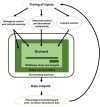A whole ecosystem approach to pear psyllid (Cacopsylla pyri) management in a changing climate
- PMID: 39188924
- PMCID: PMC11344733
- DOI: 10.1007/s10340-024-01772-3
A whole ecosystem approach to pear psyllid (Cacopsylla pyri) management in a changing climate
Abstract
Whole ecosystem-based approaches are becoming increasingly common in pest management within agricultural systems. These strategies consider all trophic levels and abiotic processes within an ecosystem, including interactions between different factors. This review outlines a whole ecosystem approach to the integrated pest management of pear psyllid (Cacopsylla pyri Linnaeus) within pear (Pyrus communis L.) orchards, focusing on potential disruptions as a result of climate change. Pear psyllid is estimated to cost the UK pear industry £5 million per annum and has a significant economic impact on pear production globally. Pesticide resistance is well documented in psyllids, leading to many growers to rely on biological control using natural enemies during the summer months. In addition, multiple insecticides commonly used in pear psyllid control have been withdrawn from the UK and Europe, emphasising the need for alternative control methods. There is growing concern that climate change could alter trophic interactions and phenological events within agroecosystems. For example, warmer temperatures could lead to earlier pear flowering and pest emergence, as well as faster insect development rates and altered activity levels. If climate change impacts pear psyllid differently to natural enemies, then trophic mismatches could occur, impacting pest populations. This review aims to evaluate current strategies used in C. pyri management, discuss trophic interactions within this agroecosystem and highlight potential changes in the top-down and bottom-up control of C. pyri as a result of climate change. This review provides a recommended approach to pear psyllid management, identifies evidence gaps and outlines areas of future research.
Keywords: IPM; Natural enemies; Orchards; Phenological mismatches; Trophic interactions.
© The Author(s) 2024.
Conflict of interest statement
Competing interestsThe authors declare no competing interests.Conflict of interestsAuthors have no conflicts of interest.
Figures




Similar articles
-
Ecology and biology of the parasitoid Trechnites insidiosus and its potential for biological control of pear psyllids.Pest Manag Sci. 2021 Nov;77(11):4836-4847. doi: 10.1002/ps.6517. Epub 2021 Jun 30. Pest Manag Sci. 2021. PMID: 34148291 Review.
-
Density thresholds and the incorporation of biocontrol into decision-making to enhance the control of Cacopsylla pyri in pear (cv. Ercolini) orchards.Pest Manag Sci. 2022 Jan;78(1):116-125. doi: 10.1002/ps.6615. Epub 2021 Sep 9. Pest Manag Sci. 2022. PMID: 34453401
-
Pandora cacopsyllae Eilenberg, Keller & Humber (Entomophthorales: Entomophthoraceae), a new species infecting pear psyllid Cacopsylla pyri L. (Hemiptera: Psyllidae).J Invertebr Pathol. 2023 Sep;200:107954. doi: 10.1016/j.jip.2023.107954. Epub 2023 Jun 23. J Invertebr Pathol. 2023. PMID: 37356706
-
Sampling of Cacopsylla pyri (Hemiptera: Psyllidae) and Pilophorus gallicus (Hemiptera: Miridae) in pear orchards.J Econ Entomol. 2011 Oct;104(5):1742-51. doi: 10.1603/ec11040. J Econ Entomol. 2011. PMID: 22066206
-
Psyllids in Natural Habitats as Alternative Resources for Key Natural Enemies of the Pear Psyllids (Hemiptera: Psylloidea).Insects. 2024 Jan 6;15(1):37. doi: 10.3390/insects15010037. Insects. 2024. PMID: 38249044 Free PMC article. Review.
References
-
- Adams R, Domeisen C, Ford L (1983) Visual trap for monitoring pear psylla (Homoptera: Psyllidae) adults on pears. Environ Entomol 12(5):1327–1331. 10.1093/ee/12.5.132710.1093/ee/12.5.1327 - DOI
-
- Agathokleous E, Feng Z, Oksanen E, Sicard P, Wang Q, Saitanis CJ, Araminiene V, Blande JD, Hayes F, Calatayud V (2020) Ozone affects plant, insect, and soil microbial communities: a threat to terrestrial ecosystems and biodiversity. Sci Adv 6(33):1176. 10.1126/sciadv.abc117610.1126/sciadv.abc1176 - DOI - PMC - PubMed
-
- AHDB (2012) Final Report-Exploiting semiochemicals, conservation biocontrol and selective physical controls in integrated management of pear sucker. https://projectbluearchive.blob.core.windows.net/media/Default/Research%.... Accessed 1 December 2023
Publication types
LinkOut - more resources
Full Text Sources
